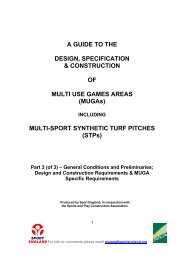View - North East Lincolnshire Council
View - North East Lincolnshire Council
View - North East Lincolnshire Council
You also want an ePaper? Increase the reach of your titles
YUMPU automatically turns print PDFs into web optimized ePapers that Google loves.
BOC Immingham Dissolved Acetylene Project Environmental Statement: Vol. 2 Main Text<br />
� dermal contact with and ingestion of:<br />
- contaminants in windblown soil and soil-derived dust<br />
- contaminants entrained in surface water run-off from areas where soil (and<br />
contaminants) is exposed at the surface, and<br />
- contaminants in perched water shallow groundwater in natural strata (if pre-construction<br />
excavation takes place below the perched water groundwater table);<br />
� inhalation of contaminants in windblown, soil-derived dust from areas where soil (and<br />
contaminants) is exposed at the surface; and<br />
� inhalation of migrating soil- and water-derived vapours and migrating ground gas.<br />
Controlled Waters Receptors and Pathways<br />
7.61 The following potential controlled waters receptors and pathways have been identified:<br />
� groundwater in the Superficial Deposits by leaching of contaminants:<br />
- from the unsaturated zone to perched water and migration vertically to the shallow<br />
groundwater, and or<br />
- from the unsaturated zone directly to the shallow groundwater;<br />
� Middle Drain (and ultimately the Humber Estuary) by discharge of contaminants entrained in<br />
surface water run-off from areas where soil is exposed at the surface (the assessment of<br />
which is addressed in Chapter 8); and<br />
� the Humber Estuary by discharge of contaminants in migrating groundwater.<br />
7.62 At this stage, groundwater in the Chalk Principal Aquifer is not considered a receptor. The Chalk is<br />
separated from the shallow near surface strata and any potential sources by over 20 m of<br />
unproductive strata (clay) as indicated in the EA’s response 4 to the Scoping Report 3 and the email<br />
response to Atkins of 09/06/2011. These strata will be of relatively low permeability and<br />
should act as a barrier to downward migration of contamination, providing they are of sufficient<br />
thickness and un-breached. In addition, downward migration of contaminants over that thickness<br />
of strata will result in attenuation.<br />
Ecological Receptors<br />
7.63 Ecological receptors are discussed in Chapter 10. As such, they have not been considered further<br />
in this Chapter.<br />
Current Property Receptors<br />
7.64 Defra Circular 01 2006 34 defines property as domestic animals, domestic produce, crops,<br />
livestock, game, fish and buildings infrastructure. At present, depending on the time of year, crops<br />
could be growing on and adjacent to the development area. There are no buildings on the<br />
development area; the nearest buildings are those at the adjacent existing BOC site.<br />
7.65 Pathways to on site crops include uptake of contaminants in shallow groundwater by roots and<br />
leaf contact with contaminants in soil-derived dust.<br />
7.66 Pathways to offsite crops require windblown, soil-derived dust for leaf contact and migration of<br />
contaminants in shallow groundwater for root uptake.<br />
7.67 The pathways to offsite buildings include direct contact with contaminants in migrating shallow<br />
groundwater and migration and accumulation of ground gas vapours.<br />
5100935.404 Environmental Statement August 2011 103




